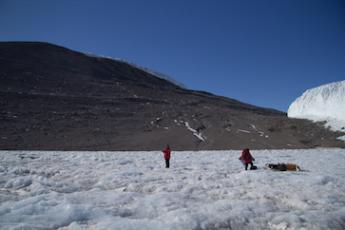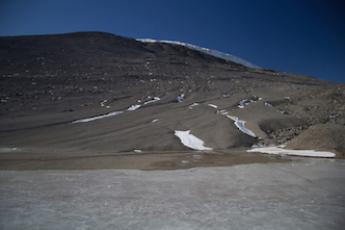Overview
Analogs are used in science investigations to better understand systems we can’t access ourselves. In this lesson, students explore the Dry Valleys of Antarctica to better understand microbial communities on early Earth and what might have been possible on ancient Mars. Students will examine photographs, written descriptions, and artistic renderings of early Earth, the Dry Valley lakes, and ancient Mars in order to compare and contrast the environments. They will then create a written assessment of whether Antarctica can be used as an analogous environment for ancient Mars or ancient Earth.
Procedure
Engage:
Have students examine the following image.
Prompt them to write about what they observe and imagine what it would be like to be in this scene. Have students pair/share, then discuss as a class. Be sure that students notice evidence of cold, water and erosion.
Next, ask them to compare the previous scene with the ones below:


Explain that the first scenes are artists’ impressions of what Gale Crater on Mars might have been like millions of years ago. The second set of images are from Lake Joyce in the Dry Valleys of Antarctica, where seasonal streams conduct meltwater and sediment down into the lake from glaciers. Explain that these environments are similar in ways that are very helpful to scientists. Share the concept of an analog with students- that we can study one environment or situation to learn more about how another environment or situation might work.
Explore:
As a class, study the NASA infographic about Mars vs Earth. Complete the student chart in which similarities vs. differences are noted. Discuss some ideas of how the environmental conditions would be helpful or harmful for life to emerge. For instance, you could discuss Mars’ very thin atmosphere. If students have prior knowledge of ancient Earth’s conditions, you could compare that to Antarctica too. (The first life forms on earth were likely to be single celled organisms and NOT a part of complex ecosystems with multicellular organisms.)
Separate students into pairs. Give each pair of students one “Ice Stories” article, and one “Antarctic Sun” article. Have each student read and annotate their article. Instruct them to look for more terms and conditions that they can add to their charts. Once they have finished reading, students report out to each other, adding data to their charts comparing and contrasting Mars and Earth.
As a class, discuss the two articles. What was most outstanding or eyepopping? What similarities did they see referenced between the infographic the class first examined and the two articles? What similarities or differences between Mars and the Dry Valleys stood out? Emphasize and/or point out that both environments, as well as early Earth are grounds for life to begin.
As a class, watch this short video by NASA:
It describes Mars as we imagine it to be from research and observations made with Curiosity rover. Explain that it is unlikely to turn into an oasis of life in the future, but it may have once been more Earth-like, and certainly has similarities to the Dry Valleys today.
Explain:
Students will now discuss and explore the question of how life and conditions on Earth be used as a model for life on Mars. They should get a copy of the chart below. Emphasize that their claim should answer the question. Circulate around to different groups to make sure that students have a claim that fits the question. Giving students time to discuss their claims, evidence and reasoning before writing individually on their charts will yield better results.
Question: How can life and conditions on Earth be used as a model for EITHER life on ancient Mars OR ancient Earth?
Claim: What is your conclusion, explanation or answer to the question?
Evidence: How do you know? What ideas support your claim?
Rationale: How do your ideas support your claim? What’s your logic behind your pieces of evidence?
(Student copy of exercize above is provided in the resources.)
As the students are working on their second charts using data from the first one, the teacher should circulate around, making sure that the claims match the questions and that evidence matches the claims. They should refer to details from their articles to guide their arguments.
Evaluate:
There are two options for evaluation within the framework provided:
- The charts for each student can be assessed for accurately using evidence to support their claim in a logical way with strong rationale.
Each student could be further asked to write a paragraph on their own. A suggested prompt:
Construct a paragraph that answers the question “How can life and conditions on Earth be used as a model for life on Mars?”. Persuade your reader that your claim is valid and well- supported. As you write your argument, remember to…
- state the claim you are supporting.
- include your evidence and reasoning for using each piece of evidence.
- include vocabulary words you have learned.
- Use proper grammar, spelling and punctuation.
Extensions
This lesson could be a jumping off point for further discussion and/or exploration:
- “terraforming” : have students investigate what would need to happen on Mars to make it more habitable for species from Earth
- continue on with an in-depth study of extremophiles: micro-organisms capable of surviving in extreme conditions. Try the follow up lesson “ Hypotheses for Life on Mars” offered by PolarTREC.
Assessment
Students can be assessed based on quality of writing on their completed Comparisons Chart and Claims, Evidence, Reasoning Chart.
Author/Credits
PolarTREC teacher, Lucy Coleman created this lesson based on her expedition with Microbialites in Lake Joyce, Antarctica. Lucy Coleman <lcoleman [at] natomascharter.org>
Standards Other
Standards Addressed
Next Generation Science Standards
Constructing Explanations and Designing Solutions
Constructing explanations and designing solutions in 6–8 builds on K–5 experiences and progresses to include constructing explanations and designing solutions supported by multiple sources of evidence consistent with scientific ideas, principles, and theories.
Construct a scientific explanation based on valid and reliable evidence obtained from sources (including the students’ own experiments) and the assumption that theories and laws that describe nature operate today as they did in the past and will continue to do so in the future. (MS-ESS1-4),(MS-ESS2-2)
Developing and Using Models
Modeling in 6–8 builds on K–5 experiences and progresses to developing, using, and revising models to describe, test, and predict more abstract phenomena and design systems.
Develop and use a model to describe phenomena. (MS-ESS2-1)
Develop a model to describe unobservable mechanisms. (MS-ESS2-4)
MS-ESS2-2. Construct an explanation based on evidence for how geoscience processes have changed Earth’s surface at varying time and spatial scales.
MS-LS1-5. Construct a scientific explanation based on evidence for how environmental and genetic factors influence the growth of organisms.
MS-LS1-6. Construct a scientific explanation based on evidence for the role of photosynthesis in the cycling of matter and flow of energy into and out of organisms.
| Attachment | Size |
|---|---|
| Download Complete Lesson (PDF - 189KB)189.41 KB | 189.41 KB |
| Download Student Worksheet (DOC - 50KB)50.25 KB | 50.25 KB |
| Download Antarctic Sun Article (PDF - 947KB)947.74 KB | 947.74 KB |
| Download Ice Stories Article (PDF - 180KB)180.47 KB | 180.47 KB |
| Download NASA Infographic (PDF - 2MB)2.05 MB | 2.05 MB |
| Download Powerpoint (PPT - 875KB)875.01 KB | 875.01 KB |
This program is supported by the National Science Foundation. Any opinions, findings, and conclusions or recommendations expressed by this program are those of the PIs and coordinating team, and do not necessarily reflect the views of the National Science Foundation.
